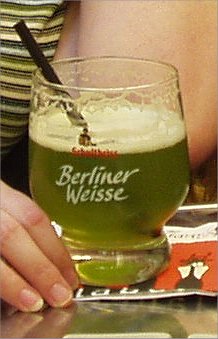Famously referred to by Napoleon's soldiers as the "Champagne of the North," Berliner Weisse is a sour, wheat-based, effervescent, low-alcohol beer traditionally brewed and drunk in Berlin, Germany. Berliner Weisse gets its trademark sourness from lactobacillus.
Berliner Weisse is traditionally drunk out of goblet-style schooner glass with a straw. To counteract the sourness, it is served "mit schuss", meaning with a shot of flavored syrup added by the bartender or drinker, that changes the flavor and color of the beer.
Contents
History of Berliner Weisse
|
This section is a stub.
|
Types of Berliner Weisse
With minor variations, Berliner Weisse is a single style as it leaves the brewery. However, the syrup, or "Schuss", used, changes the taste and color of the final beer. Common flavors are:
Woodruff
Woodruff syrup, or "Waldmeistersirup", gives the beer a herbal character at low doses and a somewhat medicinal taste at a higher dose. It also gives the beer a distinctive greenish tint, and Berliner Weisse with woodruff is sometimes called "grün", or "green".
Raspberry
Raspberry syrup, or "Himbeersirup", gives the beer a sweet fruit character and a red tint, and is sometimes called "rot" or "red".
Lemon
Less common than woodruff or raspberry, but still traditional, lemon syrup, or "Zitronensirup", gives the beer a bright "gelb" or yellow color.
No syrup
In Berlin, Berliner Weisse is always served with syrup. However, some non-German bars or restaurants that carry bottled Berliner Weisse may not have syrup available, and some sour beer fans actually prefer the sour, tart taste of a Berliner Weisse "ohne Sirup".
Brewing Berliner Weisse
Berliner Weisse is traditionally brewed with a very different process than for any other beer style. A home brewer will probably get the best result using the traditional method.
Traditional Berliner Weisse brewing
In traditional Berliner Weisse, the lactic acid fermentation is carried out by the lactic acid bacteria that already inhabit the raw grain. This is possible because the wort is not boiled during the brewing process.
To approximate the traditional method at home:
1. Add your hops to the mash tun. First wort hopping may be trendy, but it's also traditional; since the wort will never be boiled, this is the source of all of the hop character in a traditional Berliner Weisse.
2. Decoction mash. Since the entire wort volume isn't boiled, it's important to boil a decoction during mashing. This will drive off some DMS and isomerize some hop acids. Your grist should consist of pale barley malt or Pilsner malt, with a third to a half wheat malt.
3. Sparge as normal, except that instead of lautering into your brew kettle, you can lauter directly into the fermenter.
4. Pitch. Traditionally, there was enough lactic acid bacteria from the grain to add an interesting sourness to the finished beer. However, most brewers also pitch both an ale yeast and a lactic culture at this point in order to better control the fermentation, and because modern grains tend to be cleaner, or at least carry less predictable bugs. Use a clean German ale yeast, such as a Kölsch or Alt yeast, and not a Weizen yeast.
Berliner Weisse Shortcuts
While the traditional method gives the best results, there are other ways to add a sour or lactic character to the beer, while still performing a more traditional boil. These include:
- Performing an ordinary boil, but pitching a significant amount of lactic acid culture
- Performing a sour mash and adding the soured mash to the boil once the desired level of sourness is reached
- Adding acidulated malt (sauermalz) to the mash
- Adding lactic acid to the finished beer before bottling to sour
Competition Styles
Both the BJCP and GABF style guidelines recognize this style.
BJCP Style Guidelines
Berliner Weisse
| |||||||||
|
GABF Style Listings
Berliner Style Weisse (Wheat)
| ||||||
| Very pale in color and the lightest of all the German wheat beers. The unique combination of yeast and lactic acid bacteria fermentation yields a beer that is acidic, highly attenuated, and very light bodied. The carbonation of a Berliner Weisse is high, and hop rates are very low. Hop character should not be perceived. Fruity esters will be evident. No diacetyl should be perceived. For the purposes of this competition, fruited or flavored versions of the style would be appropriately entered in this category with a description of the fruit/flavor used by the brewer. |
| |||||

